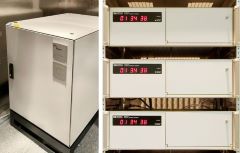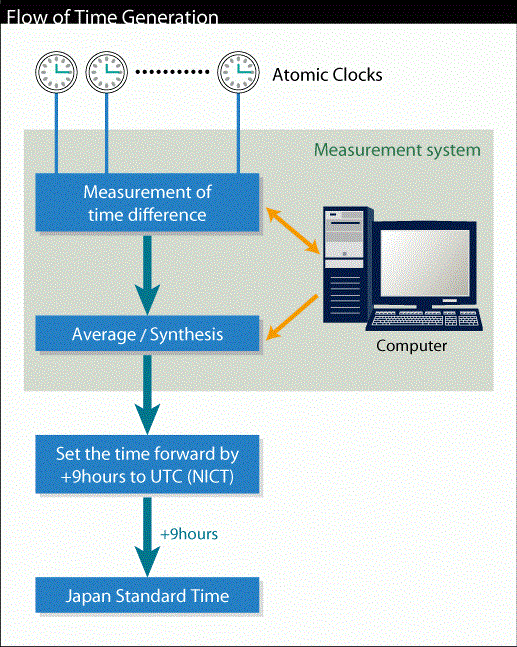Mission of Japan Standard Time Group
- The Atomic Clock

(The left picture)Hydrogen-maser clock
(The right picture)Cesium atomic clock
Japan Standard Time (JST) is generated by using a maximum of 18 sets of
cesium atomic clocks and 4 hydrogen masers in accordance with the definition
of one second mentioned above.
Cesium atomic clocks are good
for a long-term (longer than a day) stability and hydrogen masers are good for
a short-term (shorter than a day) stability.
The frequency (the number of
oscillations per second) of each atomic clock is easily influenced by the environmental
conditions such as temperature, geomagnetic field and others.
To prevent the frequency from
changing, the atomic clocks are mounted in temperature- and humidity-controlled
“Clock Rooms” with electromagnetic shielding. Furthermore, each atomic clock connects
with an uninterruptible power supply unit in case of a power outage.
- Generation of JST
The mutual time differences of the cesium atomic clocks and hydrogen masers
mounted in 4 “Clock Rooms” are measured regularly with a specific measurement
system. UTC (NICT) is generated by averaging and synthesizing (frequency
control) the times of atomic clocks once an hour.
This series of procedures for
generating JST is fully and automatically performed by several computers.
Redundant units (main and backup) work in parallel to generate the time,
ensuring continual measurement of JST even in the event of an incident such as
equipment trouble.

- Vocabulary
TAI (International Atomic Time)
determined by International Bureau of Weights and Measures (BIPM)
UTC (Coordinated Universal Time)
determined by BIPM
UTC(NICT)
determined by NICT
JST (Japan Standard Time)
set 9 hours forward to UTC(NICT).
- Establishment of Distributed Structure
Until recently the generation of JST was carried out only at the
NICT headquarters in Koganei City, Tokyo. However, at the
time of emergency, such as a serious natural disaster, in
Tokyo, the operation of JST in headquarters might be
stopped due to infrastructure damage.
To increase reliability, therefore, we are promoting research
and development for decentralization of the JST facilities. As
the first step, JST sub-station was established in Kobe City,
Hyogo on June 10, 2018.
The equipment for JST sub-station, including cesiu m ato mic clocks
and high precision satellite time and frequency transfer
systems, were installed there. The two accurate time scales
generated in Tokyo and Kobe are always compared. At the
emergency of Tokyo, Kobe Sub-station can function as the
main JST station instead of the NICT headquarters.
Development of technology to consolidate multiple time scales
will further bring more accuracy of JST by using atomic clocks of
distant stations, including the LF standard time and frequency
and development for decentralization of the JST facilities. As
transmission stations.
